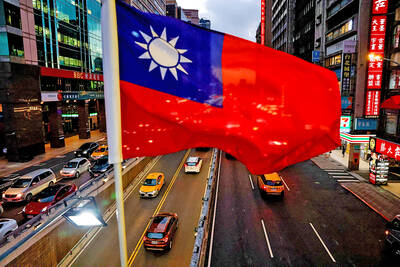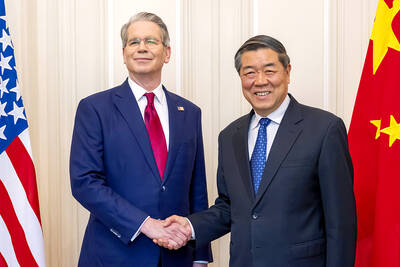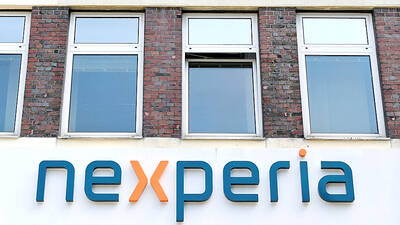Chimei Innolux Corp (奇美電子) became the nation’s top flat-panel maker on March 18, exceeding local rivals by a 1 percent margin in terms of capacity via a three-way merger. The local consolidation, however, rattled the global LCD industry.
Chimei Innolux’s hybrid business model of combining monitor and TV assembling with panel manufacturing services may even have struck a nerve on bigger South Korean competitors.
Competition has not only intensified, but the battleground has also extended to a new field — TV assembly — as Chimei Innolux’s special business model is expected to gain strength in capturing more orders, especially from TV makers.
Chimei Innolux has a strong parent company, Hon Hai Precision Industry Co Ltd (鴻海精密), backing it. Chimei Innolux is a new entity created from the merger of the nation’s No. 2 LCD panel supplier Chi Mei Optoelectronics Corp (奇美電子), Innolux Display Corp (群創光電), the world’s No. 2 LCD monitor maker and TPO Display Co (統寶光電), which makes handheld flat panels.
“Hon Hai will be a new [capacity] outlet for Chimei Innolux ... Chimei Innolux will stick to its strategy of being a provider of total solutions from panels and modules to systems [end products],” said Jeff Hsu (許庭楨), a vice president at Chimei Innolux.
Hon Hai is the world’s largest electronic manufacturing services company, making a variety of electronics from mobile phones, PCs, to TVs for global big names like Apple Inc, Sony Corp and Dell Inc.
Frank Lee (李宜家), a flat-panel industry analyst at Bank of America Merrill Lynch, said the merger came as a bombshell for the industry.
Even the world’s two largest panel makers, Samsung Electronics Co and LG Display Co Ltd, felt the threat and started adjusting strategies to fend off competition from Chimei Innolux.
“They are gardening against market share loss [to Chimei Innolux]. After all, they still sell a big portion of their capacities on the market,” Lee said.
With competition heating up, it is essential that “every panel maker build a deeper partnership with certain TV makers to secure market share,” Lee said.
David Hsieh (謝勤益), a vice president at market research firm DisplaySearch, said this “is a new game. It is the game of business models. It is entering a new phase — the competition between [electronic] conglomerates.”
Chimei Innolux and Hon Hai are expected to expand shipments of LCD TV sets nearly 10-fold to 8.5 million units this year from 800,000 units last year, Taipei-based researcher Topology Research Institute (拓墣產業研究所) said.
AU Optronics Corp (AUO, 友達光電), which yielded its top position in Taiwan to Chimei Innolux, is expected to bear the brunt. To stave off competition, AUO has been “forced to accelerate capacity buildup in China. The Chinese market will provide a make-or-break opportunity for the company [to compete with rivals],” Lee said.
In March, AUO outpaced Chimei Innolux in submitting a US$3 billion investment proposal to the Chinese government to build a 7.5-generation factory in Kunshan, Jiangsu Province, to provide 40-plus-inch TV panels for Chinese customers.
AUO chief executive Chen Lai-juh (陳來助) has also emphasized that the era of capacity races is over.
“The industry is entering a new game of creating values by accessing new technologies, new products and emerging markets,” he said.
AUO diversified to new e-paper display technology by purchasing electronic ink and e-paper display maker Sipix Imaging Inc last year and enhanced its capacities to provide niche and high-margin products by acquiring Toshiba Mobile Display Co Ltd’s subsidiary, AFPD Pte Ltd for US$39.9 million.
However, the imminent threat from Chimei Innolux still tops investors’ concerns.
“AUO’s market position is at stake because of its weak TV manufacturing business,” said Roger Yu (游智超), an analyst at Polaris Securities Co (寶來證券).
“Investors now are betting more on Chimei Innolux as reflected on Chimei Innolux’s higher price-to-book ratio,” Yu said.
That implied that investors expected Chimei Innolux to create more value from its assets, he added.
On April 20, Chimei Innolux shares were traded at 1.67 times their book value of NT$29.09 at the end of last year’s third quarter, the latest figure available. AUO shares traded at about 1.13 times their book value of NT$30.67.
This year, AUO is expected to ship 2.5 million units of LCD TVs via its subsidiaries, less than one-third of combined shipments by Hon Hai and Chimei Innolux, Topology said. The gap will widen next year because Chimei Innolux and Hon Hai are expected to land more TV orders from Sony, Topology said.
AUO knows its weaknesses. To boost its Chinese market share, the panel maker is forming LCD TV panel module assembly ventures with Chinese TV makers to secure panel orders, starting with the smaller player Sichuan Changhong Electric Co (四川長虹電器) in June last year. Last month, AUO applied this approach again and obtained the board’s approval to set up TV panel module assembly lines with China’s No. 3 LCD TV maker TCL Multimedia Technology Holdings Ltd (多媒體控股) and Haier Group (海爾), ranked No. 6 in China.
With these strategic partnerships, Paul Peng (彭雙浪), a vice president at AUO, said this year: “We will provide more than 20 percent of our total LCD TV panel shipments to Chinese customers. This fast growth would have been unthinkable two years ago.”
Moreover, AUO snatched one of Chimei Innolux’s biggest customers. On April 12, AUO’s board approved the formation of a TV and module assembly venture with the world’s biggest LCD monitor maker, TPV Technology Ltd (冠捷科技), in Poland with an initial capital of US$40 million. TPV had been one of Chi Mei Optoelectronics’ biggest customers, but appeared to shift its orders away from Chimei Innolux, which now competes with TPV in the LCD monitor manufacturing business.
Any consolidation is not without its risks, however.
“In the short term, Chimei Innolux may look more attractive to investors. The new business model may take time to prove it works better,” Hsieh said.

Jensen Huang (黃仁勳), founder and CEO of US-based artificial intelligence chip designer Nvidia Corp and Taiwan Semiconductor Manufacturing Co (TSMC, 台積電) on Friday celebrated the first Nvidia Blackwell wafer produced on US soil. Huang visited TSMC’s advanced wafer fab in the US state of Arizona and joined the Taiwanese chipmaker’s executives to witness the efforts to “build the infrastructure that powers the world’s AI factories, right here in America,” Nvidia said in a statement. At the event, Huang joined Y.L. Wang (王英郎), vice president of operations at TSMC, in signing their names on the Blackwell wafer to

AI BOOST: Although Taiwan’s reliance on Chinese rare earth elements is limited, it could face indirect impacts from supply issues and price volatility, an economist said DBS Bank Ltd (星展銀行) has sharply raised its forecast for Taiwan’s economic growth this year to 5.6 percent, citing stronger-than-expected exports and investment linked to artificial intelligence (AI), as it said that the current momentum could peak soon. The acceleration of the global AI race has fueled a surge in Taiwan’s AI-related capital spending and exports of information and communications technology (ICT) products, which have been key drivers of growth this year. “We have revised our GDP forecast for Taiwan upward to 5.6 percent from 4 percent, an upgrade that mainly reflects stronger-than-expected AI-related exports and investment in the third

RARE EARTHS: The call between the US Treasury Secretary and his Chinese counterpart came as Washington sought to rally G7 partners in response to China’s export controls China and the US on Saturday agreed to conduct another round of trade negotiations in the coming week, as the world’s two biggest economies seek to avoid another damaging tit-for-tat tariff battle. Beijing last week announced sweeping controls on the critical rare earths industry, prompting US President Donald Trump to threaten 100 percent tariffs on imports from China in retaliation. Trump had also threatened to cancel his expected meeting with Chinese President Xi Jinping (習近平) in South Korea later this month on the sidelines of the APEC summit. In the latest indication of efforts to resolve their dispute, Chinese state media reported that

CHINESE EXPORT CURBS: A dispute between China and the Netherlands could halt chip supply, affecting vehicle production, US and European auto associations said Groups representing major automakers late on Thursday warned that a chip disruption stemming from a dispute between China and the Dutch government could quickly affect US auto production. Automakers and their suppliers received notice from chipmaker Nexperia (安世半導體) last week that it could no longer guarantee delivery of its chips, the European Automobile Manufacturers Association said, adding that manufacturing could be significantly disrupted. In the US, the Alliance for Automotive Innovation, which represents General Motors, Toyota, Ford, Volkswagen, Hyundai and nearly all other major automakers, urged a quick resolution. “If the shipment of automotive chips doesn’t resume — quickly — it’s going to